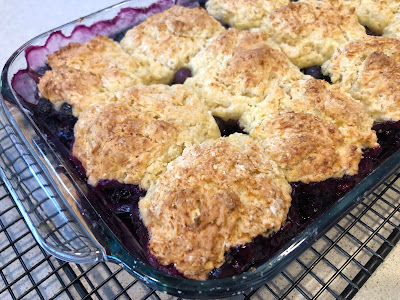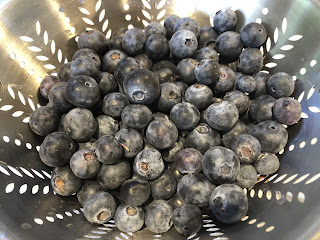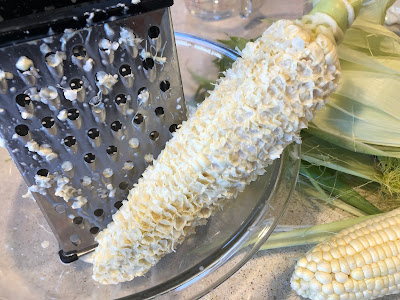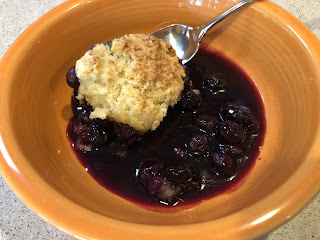
Recipe: Berries are topped with corn-infused biscuits

(Photos: Kathy Morrison) |
How fortunate that blueberries and corn come into season together -- they're a beautiful team in so many dishes.
This simple cobbler, which combines a Chez Panisse recipe with the best part of a New York Times recipe, uses them together in a surprising way: The ears of corn are grated -- "milked," if you will. The resulting chunky liquid is all the moisture needed for the biscuit dough on top of the lightly sugared blueberries. The corn flavor is subtle but delightful.
Serve it with a scoop of ice cream for the perfect dessert celebrating corn-and-blueberry season.
Note: Frozen blueberries would work just fine in this recipe, but don't defrost or wash them first.
Blueberry cobbler with fresh corn biscuits
Serves 6
Ingredients:
4-1/2 to 6 cups of blueberries, picked over to check for stems

1/3 cup granulated sugar
1 tablespoon all-purpose flour
Zest from 1 lemon (optional)
Dough:
2 large ears of sweet corn, husks and silks removed
1-1/2 cups all-purpose flour
1 tablespoon fine cornmeal
1/2 teaspoon kosher salt
 |
|
This is the unexpected part: A fresh, plump ear of corn is
grated to release the milk and solids.
|
1-1/2 tablespoons sugar
2-1/4 teaspoons baking powder
4 tablespoons cold unsalted butter, cut into chunks
Sugar or heavy cream for sprinkling, optional
Ice cream, yogurt or heavy cream for serving, optional
Instructions:
Heat oven to 375 degrees.
Wash and pat dry the blueberries. (Don't wash frozen berries.) Place the berries evenly in an ungreased 2-quart baking dish and sprinkle the 1/3 cup granulated sugar over them. Sprinkle on the 1 tablespoon flour and the lemon zest (if using), and stir briefly to distribute. Set the dish aside.
 |
|
About 1 cup of solids and milk came from 2 ears
of corn, grated and scraped.
|
Set a box grater in a large bowl or dish, and grate each of the ears of corn into the bowl, turning as necessary. The kernels will shred, releasing the milky juice inside. (An angled grating motion limits splatter.) Don't discard the cobs yet! Take a sharp knife and run it along each of the cobs to press out any remaining liquid and usable solids.
Measure the creamy corn milk and solids -- there should be at least 3/4 cup and likely more. If less than 3/4, add enough cream, buttermilk or a nondairy milk to equal that. If there's more, don't worry -- you'll use it.
Now stir the 1-1/2 cups flour, the 1 tablespoon cornmeal, 1/2 teaspoon salt, 1-1/2 tablespoons sugar and the baking powder together in a large bowl.
Add the chunks of butter, cutting them in with a pastry blender, two knives or your fingers, until the mixture resembles coarse meal.
Stir in the corn milk and solids, gently, until the dry ingredients are moistened. Form the dough into patties, using a heaping tablespoon to measure it out. Wet your hands between patties to keep them from sticking, if necessary.
Patties should be roughly 1/2-inch-thick and 2-1/2 inches across, but that's not exact and may be adjusted depending on the size of the baking pan. The key with cobbler is to leave some of the fruit exposed so it bubbles and helps cook the dough.
 |
| What's missing? Oh yes, the ice cream. |
Sprinkle the patties with a bit of crunchy sugar or brush on a little cream, if desired.
Put the baking dish on a flat baking sheet to catch any overflow, and place in the oven. Bake 30-35 minutes until fruit is bubbling in the middle as well as along the sides, and the biscuits are golden brown.
Remove to a cooling rack and allow to cool 5 minutes or so before serving. Serve in bowls with ice cream or heavy cream, as desired.
Comments
0 comments have been posted.Sacramento Digs Gardening to your inbox.
Sites We Like
Garden Checklist for week of April 21
This week there’s plenty to keep gardeners busy. With no rain in the immediate forecast, remember to irrigate any new transplants.
* Weed, weed, weed! Get them before they flower and go to seed.
* April is the last chance to plant citrus trees such as dwarf orange, lemon and kumquat. These trees also look good in landscaping and provide fresh fruit in winter.
* Smell orange blossoms? Feed citrus trees with a low dose of balanced fertilizer (such as 10-10-10) during bloom to help set fruit. Keep an eye out for ants.
* Apply slow-release fertilizer to the lawn.
* Thoroughly clean debris from the bottom of outdoor ponds or fountains.
* Spring brings a flush of rapid growth, and that means your garden is really hungry. Feed shrubs and trees with a slow-release fertilizer. Or mulch with a 1-inch layer of compost.
* Azaleas and camellias looking a little yellow? If leaves are turning yellow between the veins, give them a boost with chelated iron.
* Trim dead flowers but not leaves from spring-flowering bulbs such as daffodils and tulips. Those leaves gather energy to create next year's flowers. Also, give the bulbs a fertilizer boost after bloom.
* Pinch chrysanthemums back to 12 inches for fall flowers. Cut old stems to the ground.
* Mulch around plants to conserve moisture and control weeds.
* From seed, plant beans, beets, cantaloupes, carrots, corn, cucumbers, melons, radishes and squash.
* Plant onion sets.
* In the flower garden, plant seeds for asters, cosmos, celosia, marigolds, salvia, sunflowers and zinnias.
* Transplant petunias, zinnias, geraniums and other summer bloomers.
* Plant perennials and dahlia tubers for summer bloom.
* Mid to late April is about the last chance to plant summer bulbs, such as gladiolus and tuberous begonias.
* Transplant lettuce seedlings. Choose varieties that mature quickly such as loose leaf.